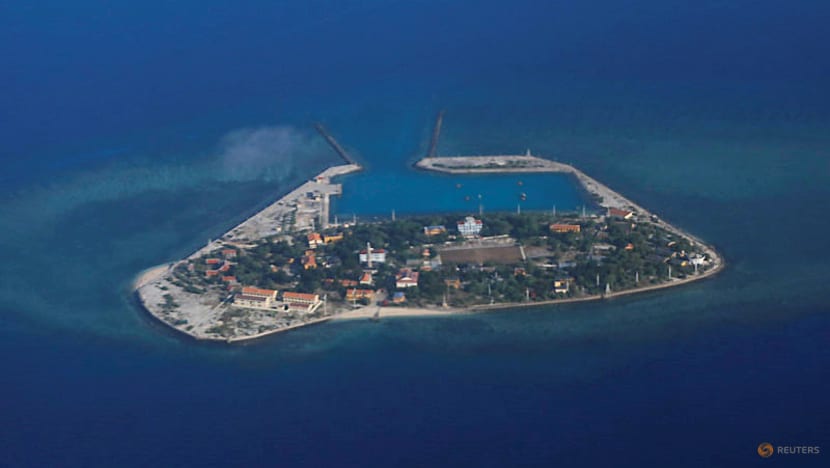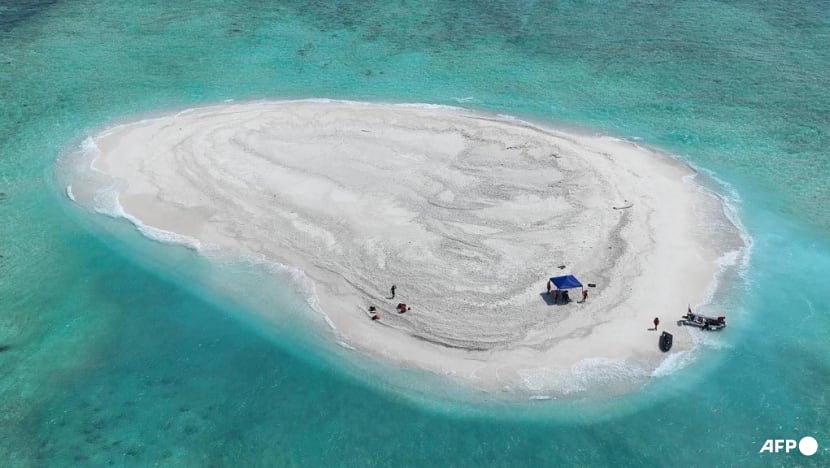Commentary: Why China has said little about Vietnam’s South China Sea build-up
Unlike its escalating clashes with the Philippines in other disputed waters, China has chosen a different reaction to Vietnam’s reclamation efforts in the Spratly Islands, says Collin Koh of the S Rajaratnam School of International Studies.

An aerial view of Southwest Cay, also known as Pugad Island, controlled by Vietnam and part of the Spratly Islands in the disputed South China Sea, Apr 21, 2017. REUTERS/Francis Malasig/Pool/File Photo

This audio is generated by an AI tool.
SINGAPORE: The scale of Vietnam’s island-building programme in the South China Sea has been a major revelation. Its reclamation efforts will possibly “match – and likely surpass” the scale of China’s own effort, according to a US think tank in August.
The Center for Strategic and International Studies’ Asia Maritime Transparency Initiative reported works at eight previously untouched terrestrial features, which meant Vietnam has now reclaimed land in every Spratly Islands feature it occupies.
Still, Vietnam’s steps are relatively modest, considering its resource constraints. But they are conceived of as a long-term blueprint in its enduring territorial dispute with China.
Beijing is not blind to what Hanoi is doing. Vietnam’s build-up has been well documented in recent years. But the Chinese authorities have maintained a deafening silence – until lately.
In contrast with its intensifying clashes with the Philippines elsewhere in the South China Sea, China and Vietnam are in a form of peaceful coexistence.
“PROPERLY MANAGE” DISPUTES
Strategic relations between Vietnam and China have been on an upswing since the 2014 Haiyang Shiyou 981 oil rig incident off the Paracel Islands, and the 2019 Vanguard Bank standoff. Both countries had since agreed to “properly manage” their disputes, implying they would refrain from “naming and shaming” each other.
International attention has also mainly been on China’s activities in the South China Sea, from its coercive acts against Philippine vessels since early 2023 to, most recently, its plan for a nature reserve at the disputed Scarborough Shoal that has drawn scepticism.
This created pretty good space – an unprecedented “strategic window of opportunity” if one might call it – for Hanoi to push on with its own island-building plans without attracting attention.
Why would Vietnam embark on such a massive and remote project? Funds could be used for domestic infrastructure and programmes instead, or to beef up the navy and key maritime law enforcement agencies, namely the Coast Guard and Fisheries Surveillance.
In a nutshell, Beijing’s island-building project has been, and will always be, the leading strategic motivation for Vietnam’s own project.
The expanded infrastructure highlighted in the think tank report is likely to facilitate Vietnam’s greater presence in the Spratly Islands group, especially given the vast geographical distance that could pose operational challenges for military and coast guard assets.
With the enhanced artificial island outposts, Vietnam can prolong the endurance of its more limited assets in the area without having to necessarily return them to the mainland bases after each sortie. With infrastructure that at least matches or compares favourably with those built by China, Vietnam could hope to stand up a more robust presence in the Spratlys.
IMPACT ON STATUS QUO IN THE SOUTH CHINA SEA
How does this affect the current situation in the South China Sea?
First, Vietnam has by far more extensive claims compared to the other Southeast Asian claimants to the Spratlys, but it does not enjoy the best of the geographical circumstances.
Brunei, Malaysia and the Philippines assert their claims within close proximity to their respective coastlines, especially well within their exclusive economic zone (EEZ) limits of 200 nautical miles (or about 370km).
Vietnam’s claims in the Spratlys are over 200 nautical miles from its mainland coastline. Sprucing up those features it occupies would allow Vietnam to assert a more robust presence, and help offset the geographical disadvantage.
Other Southeast Asian claimants will keep an eye on what Hanoi is doing. But given improving ties over the decades, they are more likely to conclude that what Hanoi is doing is aimed at Beijing.

Second, matching or surpassing what China has built may not necessarily alter the balance of power to Vietnam’s advantage.
Chinese analysts, including People’s Liberation Army officers I spoke to, recognised that Beijing’s artificial island outposts, given their geographical distance from the mainland, would be highly vulnerable in times of conflict. These outposts are regarded more as liabilities than assets when a shooting war happens, since they could potentially be cut off and neutralised or destroyed within the opening hours. Vietnam likely recognises this conundrum as well.
For both, the real strategic utility of these outposts lies in peacetime projection of presence. Hanoi witnessed first-hand the real fruits of build-up efforts. In late 2019, when a Chinese seismic survey ship Haiyang Dizhi 8 made forays into Vietnam’s EEZ near energy-rich Vanguard Bank, the Chinese only had to withdraw eastward to the Fiery Cross Reef outpost to replenish and rest, before returning to face off the Vietnamese.
There is another practical limitation: Artificial island outposts are static infrastructure, and Vietnam still pales in terms of mobile assets like military and coast guard assets required to assert its claims.
In sum, the status quo between China and Vietnam in the South China Sea goes beyond the artificial island outposts and into their respective capacities to project presence.
BEIJING’S MUTED RESPONSE
China did feel a need to respond following the publication of the report, at least to demonstrate that it is watching closely and which thus serves as a subtle warning to Hanoi. The Chinese Foreign Ministry said at a press conference on Aug 25 that it “firmly opposes relevant countries’ construction activities on islands and reefs they illegally occupy,” in response to a question, and that it “will do what is necessary” to safeguard its interests in the disputed waters.
Rhetoric aside, there are two key reasons why China has thus far refrained from reacting forcefully against Vietnam.
First, Beijing enjoys an overall power preponderance vis-à-vis Vietnam. The second, and perhaps more crucial of all, is that at present much of China’s bandwidth is directed at the Philippines, and it would rather maintain a stable front with the other Southeast Asian rivals in the South China Sea.
There are recent indications of mutual efforts exerted by Vietnam and the Philippines to forge closer maritime security cooperation, such as the recent bilateral coastguard exchanges and joint exercise. Vietnam’s ambassador to the Philippines Lai Thai Binh also spoke at various Philippine government-sponsored events that either help promote Manila’s assertive transparency approach or commemorate the 2016 arbitral award that handed a landmark Filipino legal victory against Beijing in the South China Sea. These should serve as a timely reminder to Beijing that Hanoi holds the Manila card of leverage.
With the aim of isolating the Philippines among the other Southeast Asian parties in the South China Sea, Beijing clearly wishes to keep Vietnam on its good side and has thus far elected not to overreact. Realistically, Vietnam’s build-up is unlikely to reach a point that would make China change its mind – so long as Hanoi refrains from altering its longstanding policy of maintaining buoyant economic and political ties with Beijing.
Collin Koh is Senior Fellow at the S Rajaratnam School of International Studies, based at Nanyang Technological University, Singapore. He primarily researches maritime security and naval affairs in Southeast Asia, including the South China Sea disputes.



















